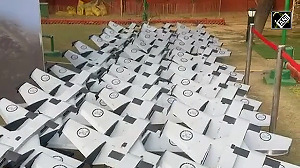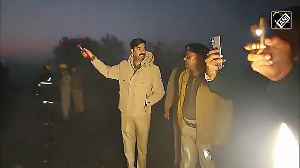Mumbai has its first date with a solar eclipse in the new millenium on Monday afternoon, at 4.12 pm (IST), but the city's hopes of viewing the celestial spectacle are fast fading as dark clouds shroud the Mumbai skyline.
Like the last solar eclipse seen from India in 1999, this one too will be viewed partially across the country, with only the outer ring of the Sun being visible. This is known as an annular solar eclipse.
Nehru Planetarium Director Piyush Pandey said he saw a 10 per cent chance of the cloud cover clearing up before the eclipse. The planetarium has arranged for telescopes, a giant screen for projecting the eclipse, and will distribute disposable solar glasses for aficionadoes who turn up to witness the event.
"We expect a number of people, including amateur astronomers, to come to the planetarium to witness the eclipse," he added.
Since the Sun will set late, after the eclipse, the west coast would be the preferred location for viewing it, planetarium officials said, adding that 27 per cent of the Sun's diameter will be covered, as seen from Mumbai, at the peak of the eclipse. The eclipse will conclude at 6.03 pm.
According to Pandey, even though the city would be able to view the cosmic drama partially next year as well, it would have to wait until July 22, 2009, to witness a full solar eclipse.
What is a solar eclipse?
A solar eclipse can occur only during new moon, when the Moon passes between the Earth and the Sun. If the Moon's shadow falls upon Earth's surface at that time, we see some portion of the Sun's disk covered or 'eclipsed' by the Moon. Although new moon occurs every 29 1/2 days, solar eclipse don't happen at the same frequency since the Moon's orbit around Earth is tilted 5 degrees to Earth's orbit around the Sun. As a result, the Moon's shadow usually misses Earth as it passes above or below our planet during new moon. At least twice a year, the geometry lines up just right so that some part of the Moon's shadow falls on Earth's surface and a solar eclipse eclipse is seen from that region.Precautions to be taken while viewing the solar eclipse
- Avoid direct eye contact during the annular phase of the eclipse. Even when 99 per cent of the Sun's surface is obscured during the partial phases of a total eclipse, the remaining photospheric crescent is intensely bright and cannot be viewed safely without eye protection.
- The safest way to view the eclipse is by projection, in which a pinhole or small opening is used to cast the image of the Sun on a screen placed half a meter or more beyond the opening. Projected images of the Sun may even be seen on the ground in the small openings created by interlacing fingers, or in the dappled sunlight beneath a leafy tree.
- Filters, having a thin layer of aluminum, chromium or silver deposited on their surfaces, can be used as they attenuate ultraviolet, visible, and infrared energy. One of the most widely available filters for safe solar viewing is a number 14 welder's glass, available at hardware outlets. However, filters like colour film, some non-silver black and white film, medical x-ray films with images on them, smoked glass, photographic neutral density filters and polarizing filters should be avoided.
- While older children can use eclipse viewers, children under 10 should watch the partial eclipse only on television, or with an indirect viewer. Children should be closely supervised while watching the eclipse.





